The Saurian Expedition of 1905 participants
UCMP has a fine record of a 1905 field expedition to Nevada thanks to a scrapbook put together by one of its participants, Annie Alexander, the woman to whom the museum owes its existence.
Seven people were involved in the venture. Besides Annie, there were:
Eustace Furlong, Geological Assistant in the Department of Geology (this predates the formation of a Department of Paleontology) at Berkeley and leader of the expedition.
Edna Wemple who, like Annie, was a former paleontology student of Professor John C. Merriam.
John C. Merriam, Professor of Geology and the first vertebrate paleontologist at Berkeley.
William Boynton and Malcolm Goddard, two Berkeley students (probably not paleontology students).
James P. Smith, Professor of Paleontology and Mineralogy at Stanford University.
The expedition lasted about two months. Furlong, Alexander and Wemple arrived at South American Canyon in the West Humboldt Mountains on Monday, May 8. Annie and Edna spent 56 days there. On Friday, May 12, Merriam, Boynton, and Goddard joined the crew. Merriam stayed for a week and a half; Goddard stayed for less than three weeks. It is not clear when Smith joined the group but it must have been at least a good two weeks in and he only stayed for a week.
So most of the work was done by Furlong, Alexander, Wemple and Boynton; by the end of June, only these four remained. Annie and Edna left the canyon for Mill City with a wagon-load of bones on Monday, July 3. Alexander did not say whether they waited for Boynton and Furlong before making the trip back to Berkeley.
Biographical information about Alexander and Merriam already exists on this website but their companions on the expedition are worth getting to know. Let's take a look:
EUSTACE LEOPOLD FURLONG (1874-1950)
Furlong may be the most underappreciated man to have ever worked with the UCMP collections. He made significant contributions to those collections, prepared dozens of vertebrate fossil specimens, and did extensive cataloging of the museum's early collections. He also helped save the fossils from destruction as we'll discover shortly.Eustace Leopold Furlong was born in San Francisco, one of at least three children, in 1874. His father, Matthew William Furlong of Rhode Island, was a sea captain who came to California seeking his fortune in the gold fields. Eustace attended San Francisco public schools and prior to enrolling at UC Berkeley, spent a considerable amount of time mining in the Sierra Nevada (probably with his father).
Although the vertebrate paleontologists at UCMP are familiar with Eustace, few realize that his older brother by two years, Herbert W. Furlong, was a preparator and field worker for John C. Merriam before Eustace. As a student at Berkeley, Herbert accompanied Merriam on two trips to the John Day region of Oregon and led a successful expedition to Crater Lake in Shasta County. According to an August 3, 1905, article in the Oakland Tribune, Herbert even authored a book called Story in the Sand that was "being used throughout the United States as a text book" (a Google search brought up no trace of such a book). Unlike Eustace, Herbert did not catch the paleontology bug and pursued other interests following his graduation from Berkeley in 1903.
When Herbert left, Eustace stepped into his brother's shoes as preparator and field worker for Merriam. Eustace was a member of Sigma Xi and graduated from Berkeley in 1906. He stayed on at Berkeley as a Geological Assistant (again, this was before there was a Department of Paleontology). Like his brother, Eustace made trips to the John Day and to Shasta County helping to collect specimens. He accompanied Annie Alexander on a number of field trips and became one of her favorites.
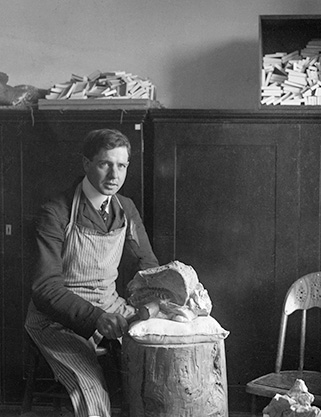
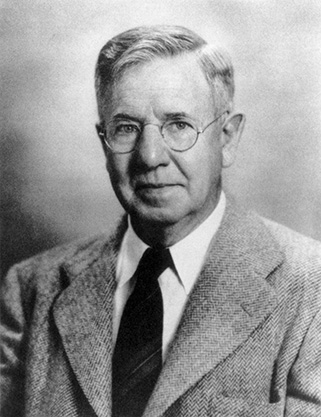
Click on either photo to see an enlargement. Left: A young Eustace Furlong (or possibly his brother Herbert), circa 1901, preparing a fossil skull in South Hall. From UCMP's Large Format Negative Collection. Right: A formal portrait of Furlong taken during his later years at Cal Tech, probably around 1940. Photo courtesy of The Bancroft Library (call no. 13:3506).
Two interesting newspaper articles in the Oakland Tribune were found that concern Furlong. This first one, from the September 2, 1905, evening edition (page 1), announced his secret marriage to Ida Hopper in Jackson, California, (apparently he had told no one about it) but it also describes some of his paleontology work. Here is a portion of the article:
PROFESSOR STEALS A MARCH
Takes a Bride and Gives Berkeley a SurpriseMr. Furlong is assistant to Professor John C. Merriam of the Berkeley seat of learning. His specialty is paleontology, and his original researches in this line have resulted in discoveries of great interest to the scientific world.
Mr. Furlong has conducted extensive investigations in the Potter Cave regions of Shasta county and has discovered the names of many cave animals, which are much like in character to the human life of ancient times. [sic]
Mr. Furlong's investigations have also been conducted in the lime-stone [sic] formation of the Sierra Nevada region, and in Nevada particularly, where he has worked with Professor Merriam in finding fossils that are considered of extraordinary value in the field of paleontology.
This summer Mr. Furlong was again assigned to work in the Shasta regions, but before beginning his scientific researches he stopped at Ione to claim his promised bride.
After the ceremony, Furlong took his new wife to Shasta County for a somewhat unconventional honeymoon: she got to watch Eustace busy himself with his field work. Ida remained with Eustace until his death and provided him with two daughters. The wedding and Shasta County work took place just a few months after Furlong returned from the Saurian Expedition.
The second article concerns an event that took place just before the Saurian Expedition. It appeared in the March 25, 1905, issue of the Tribune:
FIRE THREATENS SOUTH HALL
University Building at Berkeley Has Narrow Escape from FlamesOnly the timely discovery of Richard Rowe, a janitor at the University of California, prevented the destruction by fire this morning of historic South Hall, one of the oldest and largest buildings at the State University.
Aided by Eustace Furlong, an instructor in the Department of Anthropology [poor reporting], he fought the flames, which started on the third floor, with buckets of water placed in the hall for just such emergencies.
For a time it seemed as if the flames would get beyond their control, and an alarm was turned in, to which the University fire department responded. Rowe and Furlong, with their buckets, however, quenched the flames and the services of the firemen were not needed.
The building is valued at about $50,000, but on the third and second floors all the specimens and valuable finds of Professor Merriam, which are of priceless value to science, are stored. These finds, which represent the latest and most important work in anthropology [sigh] in America, could never have been replaced had the fire once swept through the building.
The fire started from crossed electric wires in the dark room of Professor Merriam's department. Janitor Rowe was at work in the department when the flames burst forth. He at once gave the alarm and began to fight the fire with the fire buckets. Furlong came to his aid and the fire was put out. The damage is nominal.
So the entire fossil collection that had been amassed by Joseph Le Conte and Merriam up to that time could have been completely destroyed if not for Furlong and an alert janitor!
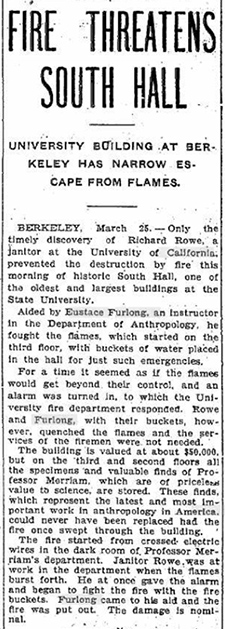
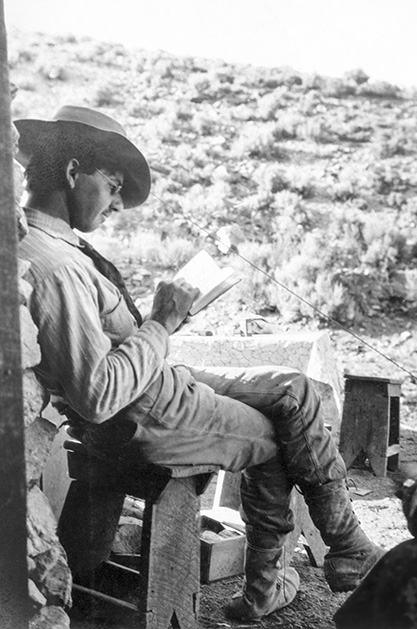
Left: The article from the March 25, 1905, Oakland Tribune. Right: Eustace Furlong relaxing during the 1905 Saurian Expedition to the West Humboldt Mountains of Nevada. Photo from Annie Alexander's Saurian Expedition of 1905 scrapbook, UCMP archives.
By the time Furlong left the museum in 1910 to try his hand at real estate, he had published six papers, five of them on Pleistocene cave fauna. He was either unsuccessful as a real estate agent or unhappy (or both) because he returned to his assistant position at the museum in 1914. During this second phase at Berkeley, Furlong and his wife lived at 1031 Glendora Avenue in Oakland.
In 1921, the year that Annie made an endowment for the creation of a Museum of Paleontology at Berkeley, Furlong was made curator of the vertebrate collections at Annie's recommendation. Furlong served in that capacity until 1927 when he was lured away to the California Institute of Technology in Pasadena by Chester Stock and John Buwalda, both former students and collaborators of Merriam's (Merriam had left Berkeley for the Carnegie Institute in Washington, DC, just prior to the creation of the museum). Furlong remained at Cal Tech as a faculty member and curator of paleontology until his retirement in 1945. He published 11 more papers at Cal Tech, some co-authored with Stock.
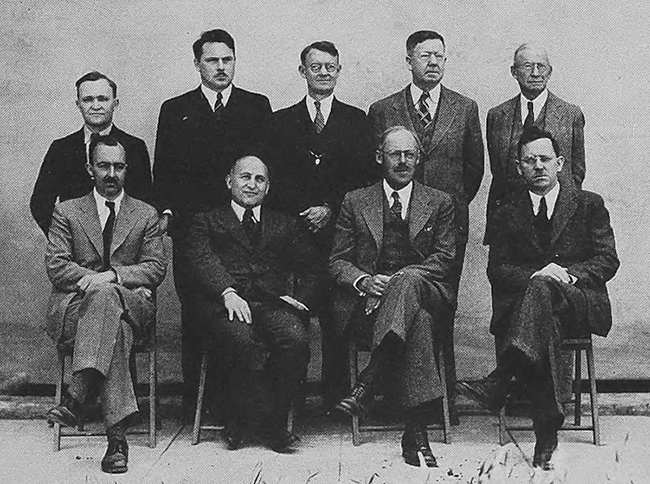
The Cal Tech geology faculty in 1936. In the back row, from the left, are Willis P. Popenoe, Horace J. Fraser, George H. Anderson, Eustace L. Furlong and John L. Ridgway; in the front row are Ian Campbell, Beno Gutenberg, J.P. Buwalda and Chester Stock. Buwalda and Stock, both students of Merriam's, taught at Berkeley before moving to Caltech in 1926. From the 1936 California Institute of Technology Big T (yearbook), published by the Associated Students of Cal Tech, Pasadena; page 23; photo by W. Albert Martin Studio.
In 1945, Furlong was invited up to the University of Oregon to prepare and study fossil mammals collected in the John Day Basin. While there he was severely injured when a car hit him and from that point on he was unable to walk unaided. Eustace died in Davis on January 18, 1950, and is buried in Woodland Cemetery, Woodland, California.
Annual Report of the President of the University 1920-1921. University of California Bulletin, Third Series, Vol. 15, No. 11, UC Press, Berkeley, Apr 1922, p. 298.
Chaney, R.W. 1951. Memorial to Eustace L. Furlong (1874-1950). Geological Society of America Proceedings. Pp. 113-14.
Some information from sources accessed on ancestry.com.
EDNA MARY WEMPLE McDONALD (1880-1958)
Edna Mary Wemple was born in Antioch, CA, one of three children, in 1880. She was one of the first members of the Prytanean Society, a women's organization ("the oldest collegiate women's honorary society in the United States"1) founded at UC Berkeley in 1901. She was also a member of the Kappa Kappa Gamma sorority at Berkeley, and later (1928) served as president of the San Francisco Bay Branch of the American Association of University Women.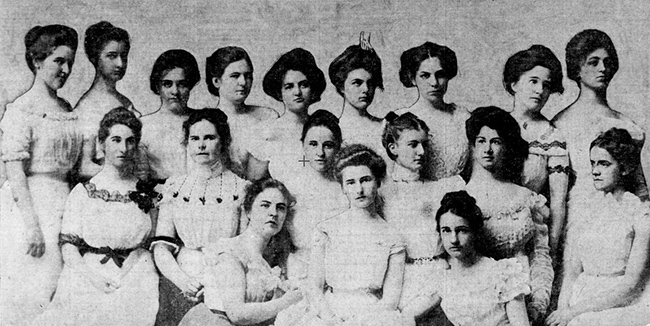
This group photo accompanied an August 24, 1901, San Francisco Call article (p. 9) on the opening of the Kappa Kappa Gamma sorority's house near the Berkeley campus. Edna is in the back row, third from the left. Based on these young ladies' expressions, one might think that sorority life wasn't much fun in 1901.
Like Annie, Edna was a paleontology student of Merriam's, and according to Richard Hilton, one of his "office staff."2 Edna accompanied Annie on at least five field expeditions, beginning with a 1903 Merriam-led trip to Shasta County. Following the 1905 trip to the Humboldts, Edna and Annie made three trips in as many years to the Kenai Peninsula in Alaska where they made a significant collection of bear specimens.
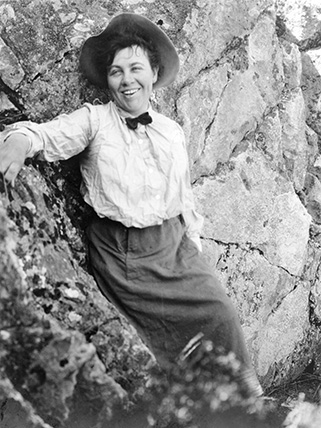
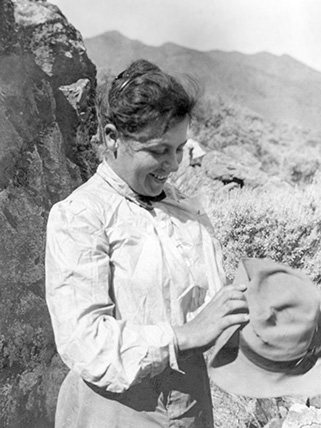
Two photos of Edna Wemple from Annie Alexander's Saurian Expedition of 1905 scrapbook, UCMP archives.
Edna received her Bachelors degree in 1903; in 1908 she became the first woman to receive a Master of Science degree in vertebrate paleontology at UC Berkeley.
Edna married James Roderick McDonald in 1908 and they had one daughter. In the 1930s Edna was certified as a postmaster. Edna died in San Francisco in 1958 and is buried at Cypress Lawn Memorial Park in Colma, CA.
Edna wrote to Ruben A. Stirton, then Director of UCMP and Chairman of the Department of Paleontology, in 1954 after seeing an article by Stirton in Pacific Discovery about Stirton's fossil discoveries in Australia. A copy of Stirton's response to Edna is in the museum archives. Here is a portion of the April 12, 1954, letter:
I am most grateful to you for your kind letter of 2 April. I have read considerable about you in Miss Alexander's notes on the early expeditions into Nevada and elsewhere. Therefore, it was particularly pleasing to receive your good letter.
I am only happy if my article in Pacific Discovery was of interest and stirred up your recollection of the incidents which happened at the turn of the century. It would be a great pleasure to me if I could talk to you some time about those early expeditions, and also to have you identify some of the pictures which Miss Alexander passed on to me. I certainly want to congratulate you on the fine work that you did in those early days.
Your great ichthyosaur is reposing in two places at the moment. Its body is in the Hearst Gymnasium, and its head is here in the Hearst Mining Building. We are in hopes of getting some suitable quarters in a year or so, and then I hope to bring the parts back together in a suitable display.
There is no evidence to suggest that Edna and Stirton did get together. Whether the "pictures which Miss Alexander passed on to me" are loose photographs that did not make it into the scrapbook is not clear. The ichthyosaur skeleton that Stirton refers to never was put together to make a "suitable display" in either McCone Hall or the Valley Life Sciences Building, but the skull has often made appearances on CalDay when the museum has an open house.
1 Prytanean Society quote from http://www.prytaneanberkeley.com.
2 Hilton, R.P. 2003. Dinosaurs and Other Mesozoic Reptiles of California. UC Press. Pp. 356.
Family and other information from sources accessed on ancestry.com.
WILLIAM HUTCHINS BOYNTON (1881-1959)
William was born April 18, 1881, one of three children, in California (possibly Grass Valley). His father had been a physician and his mother a nurse, so that may have influenced his chosen career to some degree.He attended UC Berkeley and graduated one year after the 1905 expedition. One can only guess that William had taken one of Merriam's paleontology classes, but it's unknown why he signed on as one of the Nevada crew. He was an associate member of both the Order of the Golden Bear — a Senior Men's Society — and of Phi Sigma — a Biological Honor Society (joining such notables as Charles Camp, Edward O. Essig, and Joseph Grinnell in the latter society). Following graduation, William focused his studies on veterinary medicine at Cornell, earning his D.V.M. in 1908.
Boynton returned to Berkeley for at least one summer after starting at Cornell to assist with the preparation of the ichthyosaur bones recovered on the expedition. This is from a June 21, 1907, issue of the Oakland Tribune (page 4):
Back From Cornell
William Boynton, who has been attending Cornell University since his graduation here, is in Berkeley for the summer months. He has taken a position under Professor Merriam, at the University, and is now engaged in mounting [preparing is more likely] specimens of the ichthyosaurus [sic] collected by Dr. Merriam in a recent expedition through Nevada.
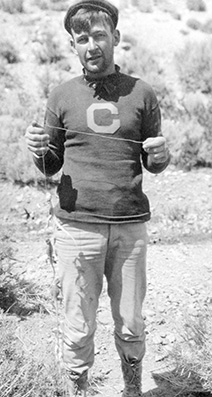
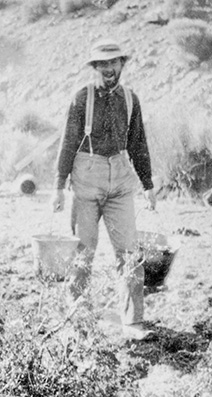
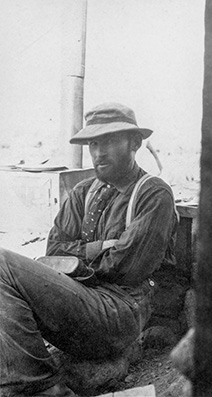
Click on any of the three photos to see an enlargement. William Boynton during the Saurian Expedition of 1905, from Annie Alexander's scrapbook, UCMP archives.
In 1908 the U.S. established a University of the Philippines and the first college to be created was the College of Veterinary Science. A variety of animal diseases had been plaguing the Philippines, particularly rinderpest, an infectious viral disease of cattle, and the U.S. Bureau of Agriculture in the Islands was finding it difficult to attract veterinarians to help combat the epidemics. Sometime after getting his doctorate, William moved to the Philippines, took a job with the Bureau as a research pathologist, and became a professor at the College. In 1923, after years of experimentation, William was successful in producing a rinderpest vaccine.
In 1924, he returned to California and joined the faculty of the University of California's Department of Agriculture. "Boynton demonstrated the natural history of anaplasmosis [by studying deer in captivity], pioneered in tissue culture, and developed a nonvirulent hog cholera vaccine."1 During this period in Berkeley, William lived at 2735 Virginia Street on the north side of campus. He retired as Professor of Veterinary Science in 1949, just a year after the School of Veterinary Medicine at UC Davis was established.
William married Clara Ethel Couling in Guelph, Ontario, Canada, in 1910. They had one daughter, Lauan. William died in Berkeley in 1959, ten years after retiring from UC. According to sources on ancestry.com, William is buried in the East Mercer Cemetery, Mercer, Maine, and his parents and two siblings are buried in the Rough and Ready Cemetery, Nevada County, California. Why William would not be buried with the rest of his family is a mystery, however, his paternal grandparents were both from Maine, so perhaps he preferred to be buried near them.
1 Osebold, J.W. Veterinary Microbiology [at UC Davis]. University of California Digital Archives. http://www.lib.berkeley.edu/uchistory/general_history/campuses/ucd/departments_v.html
Family and other information from sources accessed on ancestry.com.
MALCOLM GODDARD (1883-1938)
Of the people who accompanied Annie Alexander on her Saurian Expedition in 1905, Malcolm Goddard — dentist-adventurer-hunter — may be the most interesting.Malcolm was born in Oakland in 1883 to Clark La Motte Goddard and Emily Louise Bunker. His sister Florence was born three years later.
Clark Goddard was a respected dentist; he had been Dean of the University of California's College of Dentistry (1882-83, 1885-89, and 1899-02) located in San Francisco. Clark was the first professor of the prosthodontics section of the Dentistry College when it opened in 1881. Clark was also an amateur photographer and his collection of over 1,100 photos are in the collections of The Bancroft Library.
Clark and his wife were well-to-do and enjoyed traveling, both in California and in Europe. Malcolm and Florence would accompany them; perhaps these trips are what gave Malcolm his taste for adventure.
Malcolm enrolled at UC Berkeley around the same time that his family moved from Oakland to Berkeley in 1902. The Goddards had a house built for them at 2647 Dwight Way. It was eventually razed and replaced with UC's Unit 2 student residence halls. During the first 37 years of Malcolm's life his primary residences were in the Bay Area: Oakland, Berkeley, San Francisco and Walnut Creek.
Malcolm's father died in 1905, leaving the family an estate worth about $122,000 (around $3 million in 2017 dollars). His widowed wife Emily began investing in real estate. She bought lots on Parker and Etna Streets and had three two-story homes built on each; at least five of the six houses were designed by Julia Morgan. Later in 1905 Emily bought three lots on Elmwood Avenue (now Ashby Place) and she had Morgan design a more substantial house on one of them (2733 Ashby Place).
It was in the summer between his junior and senior years at UC when Malcolm went to the West Humboldts with Annie. Like Boynton, Malcolm probably had taken one of Merriam's classes and the idea of roughing it for a time in Nevada appealed to him.
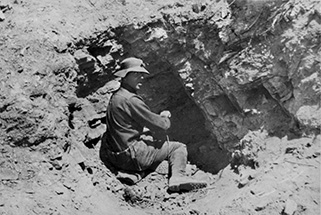
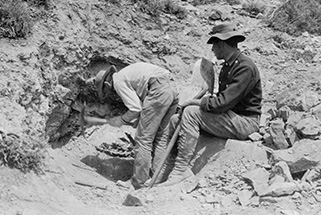
Click on either photo to see an enlargement. These two photos of Goddard working in a fossil quarry are from Annie Alexander's scrapbook, UCMP archives. In the right-hand photo, Goddard waits for Eustace Furlong to finish picking.
Goddard earned his B.S. in 1906 and, following in his father's footsteps, went on to UC's College of Dentistry to get his D.D.S. in 1909. As an undergrad, he was a member of the Phi Sigma Delta fraternity (overlapping with Herbert Furlong, Eustace's brother) and later served as President of the Dentistry College's ASUC in 1908-09. After completing his degree, Malcolm maintained a private practice in San Francisco and was an instructor of Comparative Anatomy and Odontology at the College until World War I.
Malcolm lived in British Columbia, Canada, for a portion of 1908. He returned in 1912, and with a local Native American named Kese, he became the first white man to scale three peaks in the vicinity of Lake Chilko. He named one of them after Merriam (10,167 ft). Both Malcolm and Kese were later honored with peaks of their own: Mounts Goddard (8,304 ft) and Kese (10,036 ft). Goddard Glacier also winds through the mountains nearby. Goddard wrote an article about his experience for the Canadian Alpine Journal in 1913. A group of climbers decided to retrace Goddard's route in 1987 and found a note, handwritten by Malcolm, at the summit of what is now called Mt. Chilko. Read the account and see a photo of Goddard's note.
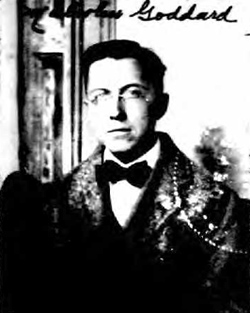
Malcolm Goddard's passport photo, from a source accessed on ancestry.com.
When the war came along, Malcolm enlisted in the Army's Dental Corps and served at various hospitals in and around Paris. He returned to the Bay Area in 1919 but went back to France the following year and began a dental practice there. In 1925 he went on safari in the French Cameroons (now Cameroon) and then another four years later in French Sudan (now Mali). At some point, he explored the mouth of the Niger River where it enters the Atlantic at the Gulf of Guinea. In 1931 he moved permanently to a ranch in Buea, British Cameroons (now Cameroon). Buea is just southeast of the active volcano, Mt. Cameroon, 13,255 ft.
An article from the February 2, 1932, Paris Edition of the New York Herald reported:
Dr. Malcolm Goddard, '09, after 12 years practice in Paris, is soon to sail from Rotterdam for Mount Cameroon, rising 13,500 feet above the exotic Ivory Coast in the British Cameroons on the west coast of Africa.
There in the village of Buena [sic], site of the British residency, he will erect a thatched villa, 3,000 feet above the sea in order "to live in a paradise of sunshine and have a place where my dog can run around," as he expressed it.
"There is everything here — climate, sea, mountains, jungle, lovely far-off shore islands" he continued. "There are no Americans there, Britons and German planters who went back after the war, forming the population. In a few hours the hunter is in one of the last two places in Africa to get gorillas, and there are plenty of all kinds of other big game. The elephants are so numerous, they come up to eat the thatched roofs. Lake Tchad [sic] is only three days away by auto truck."
In 1938 at the age of 55, Malcolm died of a heart attack near Oslo, Norway, during a trip along the Norway coast in his 24-foot boat to the country's North Cape. I believe he remained a bachelor all his life because his estate was left to his sister Florence.
Malcolm's grave is in Plot 15 of Oakland's Mountain View Cemetery, located near other family members and relatives. Incidentally, Joseph Le Conte's grave is not far away in Plot 36.
Thompson, Daniella. 2010. The Goddards and Julia Morgan: An occasional love story. Berkeley Daily Planet, 23 Apr 2010. http://berkeleyheritage.com/eastbay_then-now/goddard.html
UC Berkeley Junior Class. 1909. Blue and Gold: Being a Record of the College Year, Vol. 36. University of California Press. P. 275.
Family and other information from ancestry.com.
JAMES PERRIN SMITH (1864-1931)
James Perrin Smith was born in Cokesbury, South Carolina, one of seven children, in 1864. He attended Wofford College in Spartanburg and received his A.B. in 1884. He earned his M.A. two two years later at Vanderbilt University. Smith then taught high school for two years before joining the Arkansas Geological Survey. He went to Germany in 1890 to continue his studies and achieved his Ph.D. in 1892 from the University of Göttingen. Upon returning to the United States, Smith was invited to become Professor of Paleontology and Mineralogy at Stanford University, which had just begun admitting students in 1891. He accepted the position and remained at Stanford for the remainder of his life.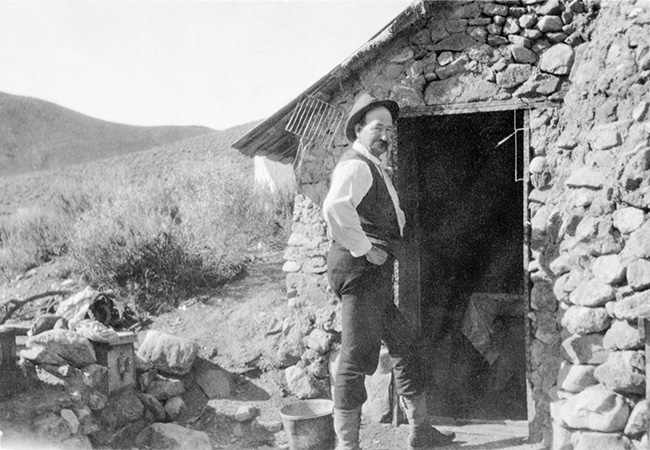
Smith outside the old cabin that the Saurian Expedition used as a base. From Annie Alexander's scrapbook, UCMP archives.
Smith married Frances Norris Rand in Manitowoc, Wisconsin, in 1896 and they had four children.
Smith's first important publication was on Arkansas marine fossils, primarily ammonoids. He found ammonoids to be so interesting that he continued to study them throughout his life. Smith's best known publication is a monograph on American Carboniferous ammonoids that he published in 1903, two years before the Saurian Expedition. The book is mentioned in Annie's scrapbook.
Smith was elected a member of the National Academy of Sciences in 1925 and received the Mary Clark Thompson Gold Medal in 1928 for his work. He was a highly regarded teacher; in 1922 a group of his former students presented him with a gift of $10,000!
He died in 1931 and is buried at the Los Gatos Memorial Park in San Jose, CA.
Plummer, F.B. 1931. Memorial: James Perrin Smith, 1864-1931. Journal of Paleontology, Vol. 5, No. 2. Pp. 168-170.
Family and other information from sources accessed on ancestry.com.